Sébastien Jupille’s story begins simply. As a kid he drew constantly, not because anyone pushed him toward art but because it was the activity he returned to on his own. When adults asked him what he wanted to do later in life, he said he wanted to draw. Even then he felt unsure about pursuing art professionally and has said he was a little scared to be an artist for a living. That hesitation shaped his early choices. If he was not going to be an artist, then he was going to draw objects.


During his teenage years designers were highly visible in France. Names like Philippe Starck were in the air and design felt like a serious and respected path. That atmosphere influenced him. He decided to study product design and moved to Paris thirty years ago to train formally. Over the next fifteen years he worked in design on products, interiors and large scale projects including yachts. The work was broad and demanding. But over time he noticed that the more advanced his career became, the less time he spent drawing by hand. Most of his days were spent on a computer. Increasingly he felt like he was imagining projects that rarely became reality. He grew frustrated with the distance between the work on his screen and any finished object.
By the time he was in his late thirties he felt the need to return to drawing with real structure. He began looking for places in Paris where he could relearn the academic fundamentals. To his surprise, he could not find the type of classical training he wanted. That search eventually pointed him toward New York. His first workshop there was a one week session with Colleen Barry at Grand Central Atelier. He has said he had a click there and realized immediately that something important was happening. The atmosphere, the rigor and the direct focus on seeing strengthened his desire to commit to drawing and painting in a more serious way.
When he returned to Paris after that workshop, he met several American artists living in the city who became essential to his development. He describes that time as a stroke of luck because the very training he had been unable to find in Paris finally appeared in front of him through those mentors. He studied intensively while slowly closing his design business. He needed time to rebuild the technical foundation he had skipped earlier in life.
The transition from design to painting also shifted how he approached his day. He had spent years working behind screens with his mind focused on hypothetical future projects. Painting from life forced him to slow down and pay attention to the present. He has said that observing a person or a tree for hours makes him feel connected to the moment in a way design work never did. Being in front of a model or a still life left no room for distraction.
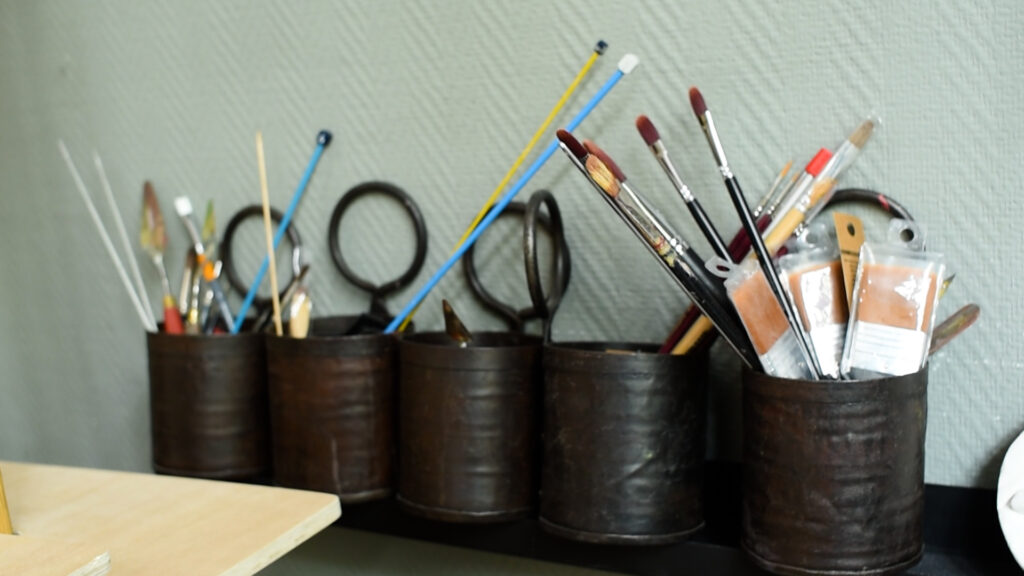
As he gained more control over his technique he returned frequently to museums in Paris. The paintings that drew him in were often Italian works or pieces from the French academic tradition. Earlier in his youth he was strongly influenced by Ernest Pignon Ernest and tried to understand how such drawings were made. Without formal training he usually landed in what he called spirals, repeating mistakes because he could not figure out how to reach the level he admired. Only through structured study did the technical problems begin to resolve.
Once he had enough skill to work independently he started finding a rhythm between personal painting, teaching and ongoing study. The balance is not perfect and he often says he needs more time and practice, but he accepts that as part of the process. A shift in himself grew stronger after his father died. It was not something he planned, but the loss brought new questions into his work. His mother had already experienced a stroke that left half of her body paralyzed and he describes her as being cut in two. The contrast between her altered presence and his father’s absence pushed him to consider larger themes. He began a series of paintings that dealt directly with both parents.
In the painting dedicated to his mother he explored the idea of separation and physical limitation through metaphor. For the painting linked to his father the process unfolded in a more unexpected way. He initially worked quickly because he felt time was running out. His father passed away before the painting was finished and he stopped working for several weeks. When he returned he no longer felt the need to match a likeness. Instead he painted what the moment meant to him. He imagined the transition between life and death as a colorful, cloudlike form. He incorporated a skull, flowers and a beetle. The beetle appears frequently in his work and he notes its role in Egyptian culture, where it was believed to carry the dead to the afterlife. The image grew from a mix of observation, memory and invention. That combination showed him he could move beyond strict realism.
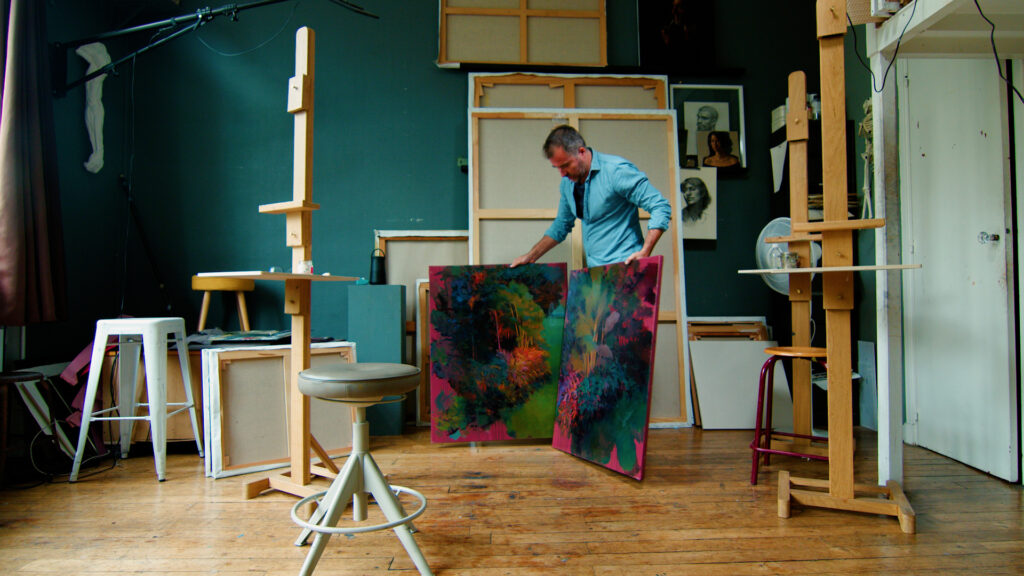
These paintings opened a path he had not previously considered. He still values the discipline of working from life, but he now feels more willing to incorporate subjective meaning. He talks about the idea of presence as a way of understanding both the physical subjects he paints and the people he has lost. When he looks at a bouquet he tries to understand its presence in a room. When he considers his parents he recognizes that although they are absent in one sense, they remain active inside him. That understanding brings him closer to abstraction because abstraction offers a way to address the parts of experience that are not visible.
His studio in Paris reflects his need for continuity and space to work. The building once housed nineteenth century artists and sits in a neighborhood where painters like Degas, Zorn, Géricault and Monet once lived. When he found the studio five years ago he knew immediately that he wanted it. The large north facing windows provide the stable light he prefers and the space accommodates both his personal work and the classes he teaches. There is a platform for models, plaster casts for value studies and compact easels built by his brother. He teaches weekly and invites artists from the United States and Canada to teach as well, building the type of training environment he once searched for himself.
His approach to materials is straightforward. He paints in oil and prefers Marais linen for its quality. He buys rolls and stretches or mounts them himself. When he travels he mounts linen on thin dibond panels because they are easier to carry. He uses artificial lighting during teaching hours to keep the model consistently lit. He varnishes his own work and treats each step of the process with the same focus he applies to painting itself.
The symbolic paintings about his parents mark a shift in the direction he wants to pursue next. He still paints portraits, landscapes and still lifes, but he wants to explore imagery that comes from his inner life as much as from direct observation. He believes the next stage of his development is finding the right distance from technique so that technique becomes a tool rather than a constraint. He is working toward a balance between external reality and internal experience.
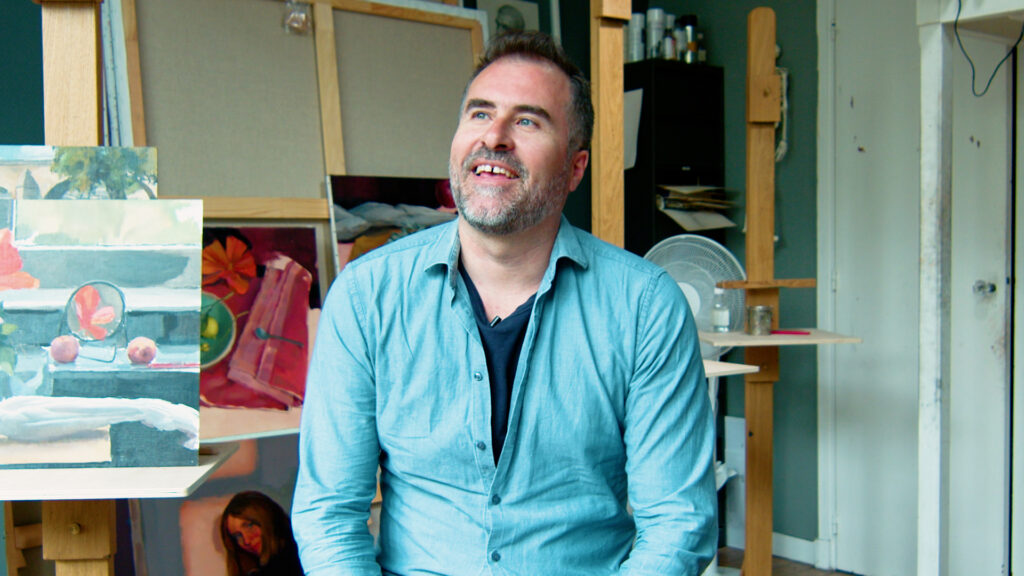
Throughout his evolution he keeps returning to the idea that painting is a way of being present. He has spent years working in different disciplines and recognizes how different this way of working feels compared to his earlier career in design. Painting requires him to slow down and pay attention in a way that reshapes his understanding of time. He continues to paint, teach and refine his practice with a clear commitment to the work in front of him.
As painting became central to his life he felt something shift internally. He needed it. He has described the necessity very clearly. For years he had spent entire days at a computer, staring at screens, imagining future projects for people he would never meet. He worked in the future and almost never in the present. Many of the projects were abandoned before they became real. With painting the opposite happened. Working from life brought him back to his own time and space. He speaks often about the effect of looking at a tree or a person for hours while making a portrait. The long observation created a strong connection with his present. Painting from life grounded him in the world instead of pulling him away from it. Over time that presence became a way of living.
His connection to old master painting deepened this feeling. Paris offered endless museums and he spent many hours studying historical work. He loved Caravaggio and Italian painting and admired the French academic tradition. He remembers being fascinated by the drawings of Ernest Pignon Ernest and wanting to understand how that kind of disciplined mark making was achieved. He realized that his own expression was limited by his lack of technique. He felt trapped until he learned the concepts that allowed him to work freely. Light, anatomy, composition and value were not simply academic concerns for him but essential tools that would allow him to express what he saw. Learning these principles allowed him to develop his brushwork and his style, and once he had the foundation he could begin to play.

He had tried in the past to develop without training. As a student he drew from life whenever he could, especially during short model sessions at school. Without guidance he found himself going in spirals, repeating the same mistakes because he did not know where to dig or how to develop. Only strong teaching helped him reach the depth he wanted. Once he had gained some understanding he felt ready to begin the lifelong balance that every artist eventually confronts. He juggles his work, his teaching, his income and his need for time at the easel. He says he is fine with the struggle but knows he needs more time and practice. He started this journey ten years ago and still feels there is more to learn, but he has reached a point where his attention shifts toward personal work. Inside himself he feels it is time.
The passing of his father marked a turning point. He speaks about it quietly but directly. His father was seventy eight and his absence opened a set of questions that began to influence his painting. Life and death and the strange transition between them became central in his mind. He began a series of large paintings that examined these ideas. Two of them are dedicated to his parents. One centers on his mother who suffered a stroke and is now paralyzed. He described her condition by saying she had been cut in two because of the paralysis and the wheelchair. He used flowers as metaphors for life, showing how beauty changes over time but never disappears entirely. The second painting explores his father’s death through a more symbolic language. He imagined something mysterious yet colorful, something immaterial like powder or ink. He speaks of the feeling that we come from the universe and return to it, and he used that idea to create the floating cloudlike form that represents his father. He added symbols including a skull and flowers and a beetle which he chose because of its connection to nature and because in Egyptian culture the beetle carried the dead to the afterlife.
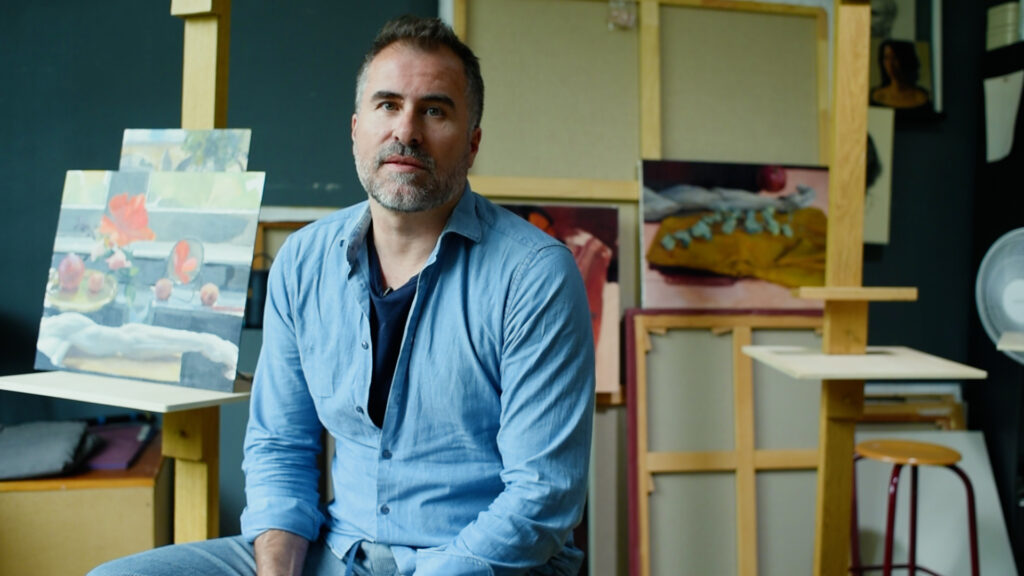
These paintings came together slowly. He began them while his father was still alive and felt a need to rush because he sensed that time was short. His father passed away before the work was finished and he stopped painting for a month or two. He considered abandoning the project because the original portrait he had started no longer reflected what he felt. Eventually he returned to the canvas and decided to paint what he felt rather than what he had planned. That decision transformed the paintings into something symbolic and personal. He estimates that each panel took around thirty hours but the more important measure was emotional. When he finished the series he understood more clearly where he wanted to go next.
He speaks openly about figuration, symbolism and abstraction as if they are strands of the same thread. He often returns to the word presence. Painting from life allowed him to understand the presence of people and objects, the way an individual exists in space and time. He says that when he paints a bouquet he tries to understand its presence with the light in a room. When he considers the presence of people who have died he reflects on how they are no longer physically here yet remain in him. This paradox is at the center of his recent thinking. It is why he now feels drawn to abstraction. Abstraction speaks to immateriality and the unseen, and it helps him address experiences that do not fit within a purely representational frame.
His studio in Paris reinforces the connection between past and present that he feels in his work. The building once housed artists in the nineteenth century and stands in a neighborhood historically filled with painters. Degas lived across the street. Zorn worked nearby. Géricault and Monet lived within a short distance. When he found the studio five years ago he recognized it as a real painter’s space. The tall windows face north, providing the kind of steady natural light that the old masters sought. The light enters less directly, allowing longer sittings without dramatic shifts.
The studio is arranged to serve both his own work and the workshops he hosts. There is a raised platform for models, plaster casts for value studies and easels built by his brother that are small enough to fit comfortably in the compact space. He teaches weekly classes and invites artists from the United States and Canada to teach as well. He builds the environment he longed for when he first searched for classical training in Paris, a place where people can learn the technical traditions that shaped him.
His materials are chosen with the same care. He works with oil paint and uses a French brand called Marais because the quality and price are exceptional. The company produces linen for museums and offers an enormous range of surfaces. He buys large rolls and stretches or mounts them himself. For travel he prefers to mount linen on thin dibond boards because they are flat, sturdy and light. If a painting does not satisfy him he simply removes the canvas and begins again. He varnishes his work in the studio and uses artificial lights at night when teaching to keep the model evenly lit.
The process behind his symbolic paintings reveals how he combines reference and imagination. For the series about his parents he worked from photographs, from life and from memory. He used a dried flower from his studio, a skull that he keeps for still life studies and a collage of images from historical paintings. Some elements emerged purely from imagination, especially the cloudlike form that represents his father. He describes it as the mysterious image he felt when he thought of the body disappearing. The technique is rooted in observation but the intention reaches into something less tangible.
He is clear that this project is only a first step. He sees it as important because it opens the way toward stronger personal work. He continues to enjoy landscape, portraiture and still life but now feels a growing desire to explore images that come not only from reality but from dreams and thoughts. He wants to find a good distance from technique so that it supports rather than limits him. He is searching for a synthesis between what is seen and what is felt, between solidity and immateriality.
In conversation he returns often to gratitude. He speaks about the luck of finding teachers, the luck of discovering a way of life in painting and the luck of being present. Presence for him is not a philosophical concept but a lived experience. It is the awareness that life is temporary and that paying attention is a kind of responsibility. He says that we are lucky to move through this life with painting and that enjoying the time we have is essential. This belief underlies everything he does, from painting trees to working on large symbolic canvases.
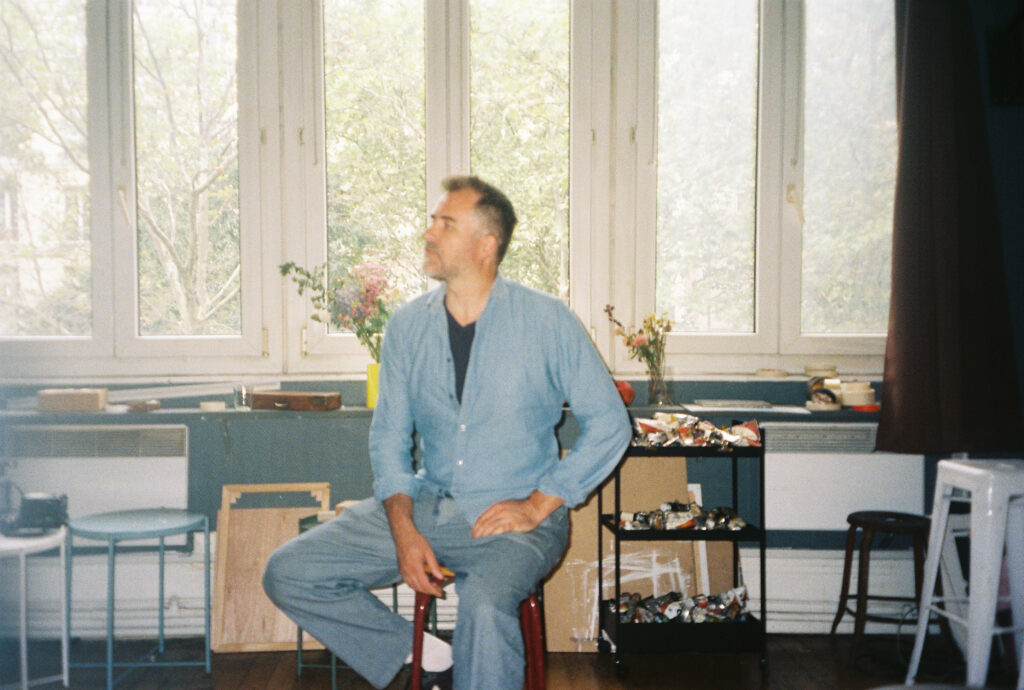
As he looks ahead he is open about the uncertainty. He plans to continue studying because study itself brings joy, but he is also committed to the task of making more personal work. He wants to take risks and move deeper into the questions that painting has placed in front of him. He wants to explore life and death and the presence of the people who shaped him. While he does not claim to have answers, he embraces the journey. He says the only real advice he can give is to enjoy the journey and work hard but to be authentic in what you look for. That authenticity runs through his own practice. His work is built on what he sees, what he feels and what he remembers, and it is becoming the language through which he continues to understand his life.
